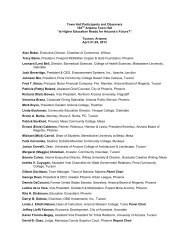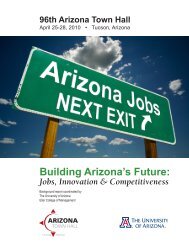Background Report - Arizona Town Hall
Background Report - Arizona Town Hall
Background Report - Arizona Town Hall
Create successful ePaper yourself
Turn your PDF publications into a flip-book with our unique Google optimized e-Paper software.
Chapter 16<br />
Cultural Institutions Outside the<br />
Metropolitan Mainstream<br />
<strong>Arizona</strong> possesses many cultural treasures outside of the metropolitan areas of Phoenix<br />
and Tucson. Anyone who has traveled throughout the state has experienced the happy surprise<br />
of discovering such places, which often represent an <strong>Arizona</strong> that has been erased elsewhere<br />
through the vigorous development that has destroyed many of the tangible reminders<br />
of our rich history. The five essays that comprise this chapter have been written by the<br />
directors of <strong>Arizona</strong> institutions in Flagstaff, Wickenburg, Bisbee, Dragoon, and Window<br />
Rock. Collectively they map the geography of our large western state. Further, they<br />
convey the challenges of presenting and preserving the arts and culture of <strong>Arizona</strong> in<br />
more remote locations. They struggle daily with how to sustain their communities, how to<br />
make significant state heritage relevant to new generations, and how to do so in a<br />
challenging economic climate.<br />
Preserving the Natural and Cultural Heritage of the Colorado Plateau<br />
Robert Breunig, Executive Director, Museum of Northern <strong>Arizona</strong><br />
The Museum of Northern <strong>Arizona</strong> (MNA) in Flagstaff, is an outstanding example of a place<br />
based museum, a regional institution. The museum is devoted to the study and interpretation<br />
of a specific part of the world, in this case the 130,000 square mile Colorado Plateau,<br />
which encompasses northern <strong>Arizona</strong>, southern Utah, and parts of western Colorado and<br />
New Mexico. The museum was founded in 1928 by citizens of northern <strong>Arizona</strong> who<br />
were concerned about the growing loss of the natural and cultural history of the region.<br />
Even some of the scientific expeditions of the time created concerns, as archaeological sites<br />
and materials were excavated by scientists from eastern U.S. institutions (such as the<br />
Smithsonian Institution) and were sent back East, never to be seen in <strong>Arizona</strong> again. The<br />
primary founders of the museum were a remarkable couple from Philadelphia who began<br />
visiting Flagstaff in 1912 and who settled permanently in northern <strong>Arizona</strong> in 1926.<br />
Dr. Harold Sellers Colton was a scientist, and his wife Mary-Russell Ferrell Colton was an<br />
artist and an art educator. Together, they built an institution devoted to both science and art—<br />
and to their interconnections.<br />
Since its founding, the museum has engaged in three principal activities: research on the<br />
geology, paleontology, archaeology, ethnology, biology and ecology, and art of the Colorado<br />
Plateau; exhibits and educational programs that “tell the story” of the region, and the<br />
building and preservation of collections that document these various disciplines. MNA’s<br />
collections contains more than 560,000 individual items plus bulk collections and<br />
archives, 9,000 sq. ft. of bulk material and archival documents and photographs. The<br />
majority of these collections are now housed in the museum’s new Easton Collection Center,<br />
a 17,000 square foot state of the art Platinum LEED facility completed in 2009 with<br />
164 | Chapter 16




